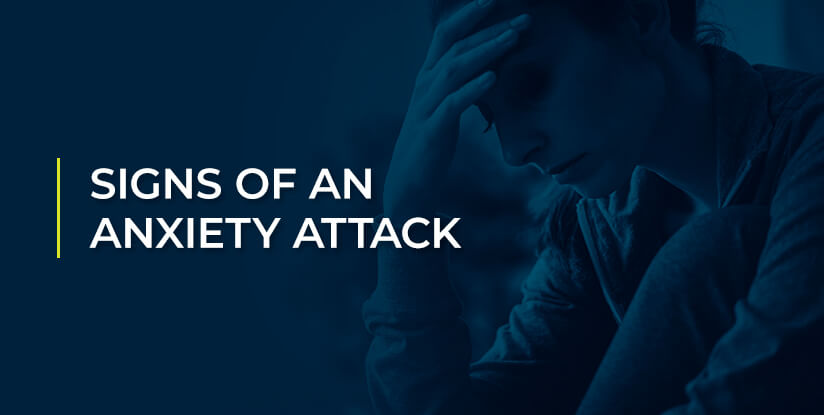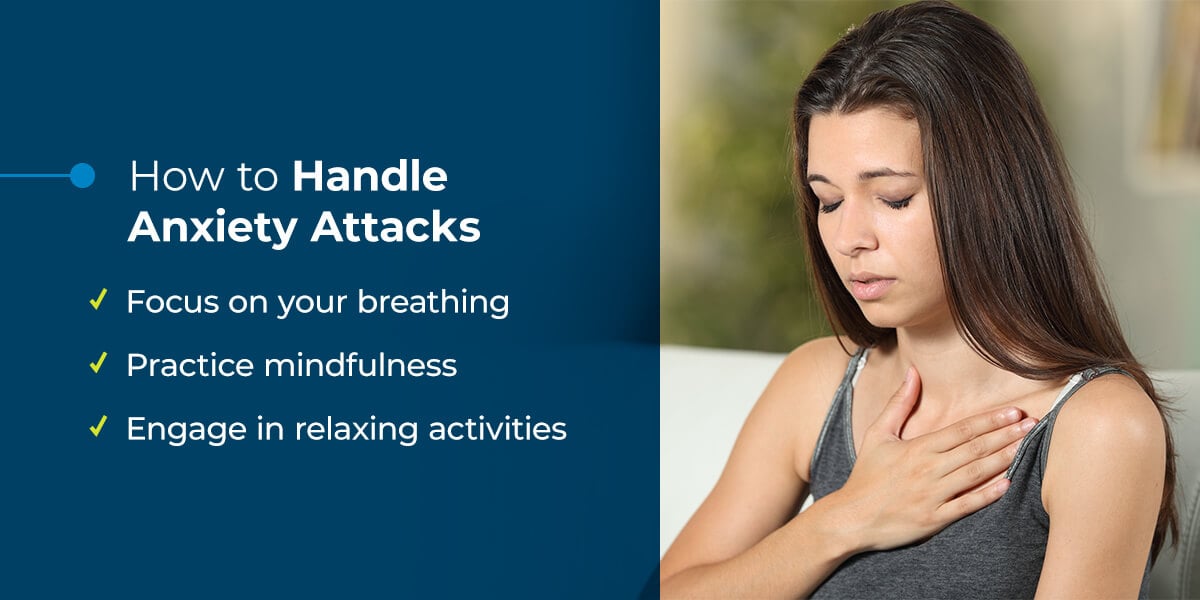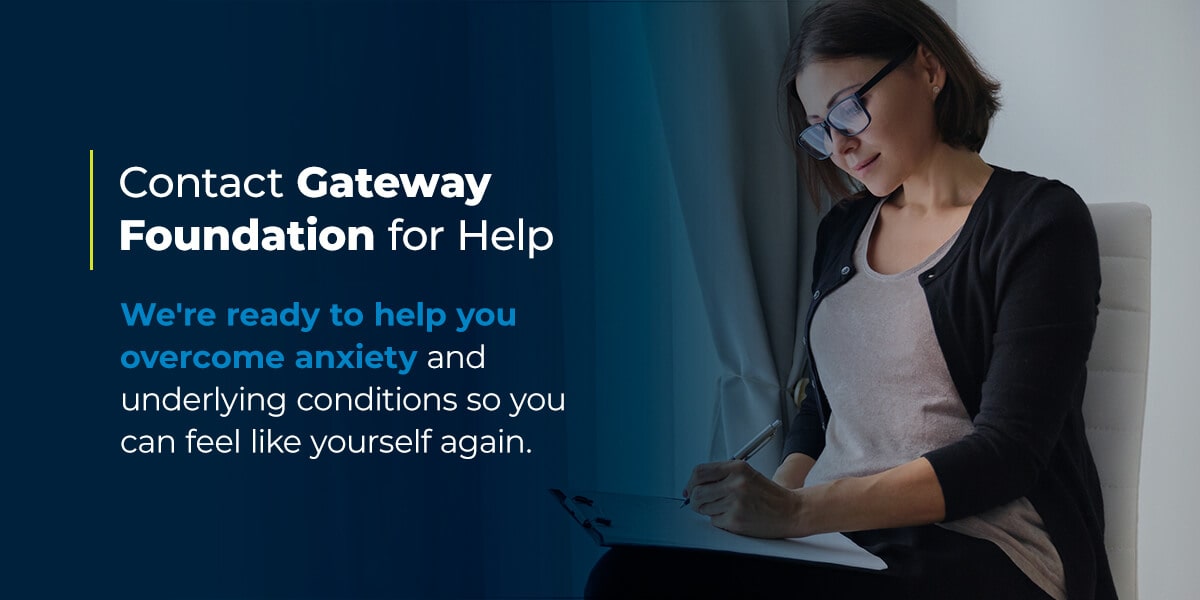- Nov 17
- Drug Addiction Treatment

Have you ever felt so stressed or worried that you couldn’t fall asleep at night? Maybe you laid in bed, unable to turn off your thoughts, feeling your heart pound in your chest. If this sounds familiar, you may know what it’s like to have an anxiety attack.
Anxiety attacks can be extremely uncomfortable and make it hard to function every day. Fortunately, anxiety is highly treatable with self-care and professional help. Understand the signs and symptoms of an anxiety attack so you can recognize the problem and get the help you need.
- What Is an Anxiety Attack?
- Anxiety Attack vs. Panic Attack
- Signs and Symptoms of an Anxiety Attack
- How to Handle Anxiety Attacks
- Contact Gateway Foundation for Help
What Is an Anxiety Attack?
Someone might use the term “anxiety attack” to describe an episode of extreme worrying, which may be accompanied by physical symptoms of anxiety. This attack might result from stress, an underlying mental health disorder or a significant life change. For example, if a person has new responsibilities at work or home, they might have anxiety until they adapt. Anxiety is characterized by worrying, fear, dread or a general sense of unease.
It’s normal to feel anxiety when something stressful happens because it’s your body’s natural way of responding to stress or a perceived threat. For instance, you might worry something terrible will happen if you have to speak in front of a crowd and experience anxiety as a result. If you have anxiety or worry excessively on most days of the week over everyday responsibilities, it might signify an anxiety disorder.
There are several types of anxiety disorders, including generalized anxiety disorder (GAD), panic disorder and social anxiety disorders. Anxiety disorders are the most common type of mental health issue, affecting about 30% of adults at some point in time.
A person might also use “anxiety attack” to describe a panic attack. However, panic attacks and anxiety attacks are two different things, even though they share a lot of the same symptoms.
Anxiety Attack vs. Panic Attack
As mentioned above, an anxiety attack describes a period of worrying that may also feature physical symptoms like muscle tension. “Anxiety attack” is not a clinical term or described in the Diagnostic and Statistical Manual of Mental Disorders, Fifth Edition (DSM-5). Recurring anxiety might point to a disorder like GAD, which is listed in the DSM-5.
A panic attack, on the other hand, is the main symptom of a panic disorder. Panic attacks can also occur with other anxiety disorders and mental health issues like depression or substance use disorder. When someone has a panic attack, they experience overwhelming physical and psychological symptoms, such as:
- Chest pain
- Increased heart rate
- Dizziness
- Choking sensation
- Sweating
- Chills
- Nausea
- Feeling short of breath
- Numbness or tingling
- Trembling
- Fear of dying
Panic attacks are very intense and can last anywhere from a few minutes to several hours. They can also come on without a warning or trigger.
An anxiety attack, however, does not feel as strong and might last longer than a panic attack, depending on the person, their life situation and whether they have an anxiety disorder. It can come with the same physical symptoms of a panic attack, though, and an anxiety attack usually has a known trigger like financial or relationship problems.
To illustrate the difference between an anxiety attack and a panic attack, imagine you’re worried about layoffs at work. You’re worrying so much, you’re not able to fall asleep at night, and the same thoughts keep cycling through your mind. You’re also experiencing headaches more frequently. You continue to struggle to sleep until you learn that your company will not be downsizing after all. This is an example of an anxiety attack.
Now, picture you’re hanging out with friends, watching a funny movie. Suddenly, you feel your heart begin to pound, and you wonder if you’re having a heart attack. You become overwhelmed by fear, so you get up and run outside, hoping the fresh air will calm you down. This is what a panic attack might look like.
Signs and Symptoms of an Anxiety Attack
Anxiety usually develops gradually and may include both physical and psychological symptoms. For example, anxiety symptoms might build as you get closer to a stressful event.
In general, anxiety symptoms are similar to a panic attack but are usually less intense. During an anxiety attack, you might have any of the following signs and symptoms:
- Fatigue
- Irritability
- Restlessness
- Muscle tension
- Worrying
- Trouble concentrating
- Difficulty sleeping
- Fear
- Lightheadedness
- Chest pain
- Heart palpitations or increased heart rate
- Shortness of breath
- Tightness in throat
- Nausea or abdominal pain
- Dry mouth
- Headache
How to Calm Down From an Anxiety Attack
If you feel overwhelmed by worry or fear, there are things you can try to help calm your mind. Here are some tips:
- Focus on your breathing: If you’re experiencing anxiety, you might be taking short breaths without even realizing it. You can feel less tense by focusing on your breathing and taking slow, deep breaths. Try taking a deep breath and then counting down from four as you exhale.
- Practice mindfulness: Mindfulness helps you stay in the present so you’re not spending all of your time worrying about the future. To practice mindfulness, notice your thoughts and then let them go. It might help to label your thoughts before letting them go. For example, you might label a thought as “fear” or “not useful.”
- Engage in relaxing activities: What relaxes you? Try any activity that helps make you feel more at ease, such as taking a warm bath, writing in a journal or getting a massage. You might also try relaxing activities that are also engaging, like exercise or arts and crafts, to focus your mind on other thoughts.
If anxiety seems to be taking over your life, it’s important to seek professional help in addition to practicing self-care. A mental health professional can determine if the anxiety you’re feeling is a symptom of an anxiety disorder or another diagnosis. They can also recommend a treatment plan tailored to your needs.
Depending on the cause of anxiety and the symptoms you’re having, treatment might include medication and therapy. For instance, doctors might suggest antidepressants and cognitive behavioral therapy to treat an anxiety disorder. Anxiety treatment often includes a combination of psychotherapy and medication.
At Gateway Foundation, we offer a range of evidence-based clinical services to address anxiety and any co-occurring disorders you may have. Our team of experienced and compassionate counselors understands that anxiety often coincides with other conditions like depression or substance use disorder, and they want to help you feel better on a holistic level.
Contact Gateway Foundation for Help
While the occasional bout of anxiety is a normal part of dealing with stressful situations, sometimes, it’s more than just a stress reaction. When anxiety disrupts your life and keeps you from feeling healthy and happy, it’s time to get help. Untreated anxiety can lead to problems with relationships and responsibilities and prevent you from doing what you love. It can also put you at risk of developing a substance use disorder or physical illness.
Anxiety doesn’t have to take over your life and health. We’re ready to help you overcome anxiety and underlying conditions so you can feel like yourself again. To learn more about our mental health treatment services, please contact us today.




